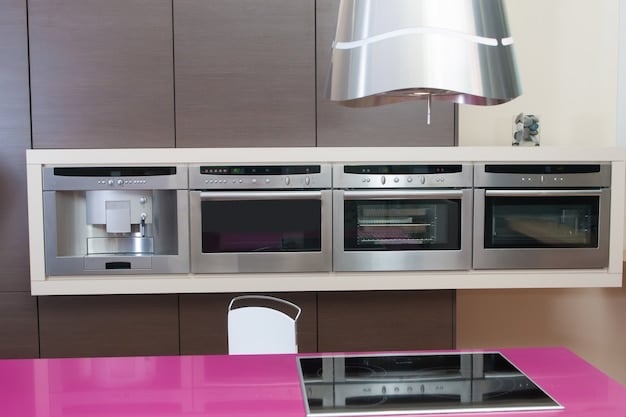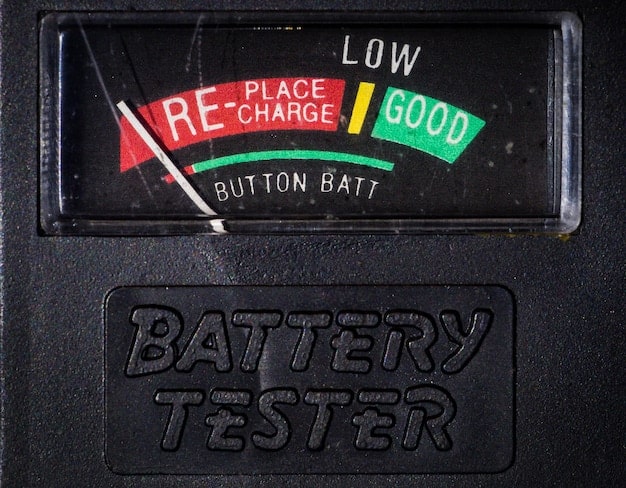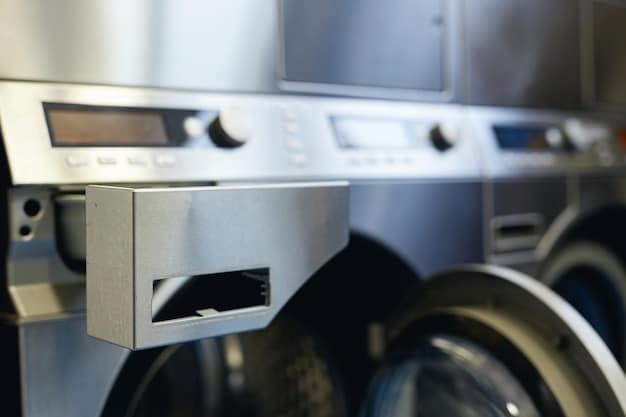Energy-Efficient Appliances: Save Money, Reduce Environmental Impact

Energy-efficient appliances can significantly reduce your energy bills and environmental impact by consuming less electricity, water, or gas compared to standard models, contributing to a more sustainable and cost-effective lifestyle.
Want to shrink your carbon footprint and lower your utility bills? Switching to energy-efficient appliances is a smart move that benefits both your wallet and the planet.
Understanding Energy-Efficient Appliances
Energy-efficient appliances are designed to use less energy while providing the same level of performance as standard appliances. This can lead to significant savings on your energy bills and reduce your environmental impact.
Let’s dive into what makes an appliance energy-efficient and how to identify such products.
What Makes an Appliance Energy-Efficient?
Several factors contribute to an appliance’s energy efficiency. These include advanced technology, improved insulation, and smarter design.
Key Features of Energy-Efficient Appliances
- Energy Star Certification: Look for the Energy Star label, which indicates that the appliance meets strict energy efficiency guidelines set by the U.S. Environmental Protection Agency (EPA).
- Lower Energy Consumption: Energy-efficient appliances consume less electricity, water, or gas compared to standard models.
- Advanced Technology: Many energy-efficient appliances use advanced technologies such as smart sensors, variable-speed motors, and improved insulation.
Choosing appliances with these features can make a big difference in your energy consumption and utility bills.

In conclusion, understanding the features that make an appliance energy-efficient can help you make informed purchasing decisions and reduce your overall environmental impact.
The Benefits of Using Energy-Efficient Appliances
Using energy-efficient appliances offers a range of benefits, from saving money to reducing your carbon footprint. These advantages make them a smart choice for any homeowner.
Here are some compelling reasons to switch to energy-efficient appliances.
Reduced Energy Bills
One of the most immediate benefits of energy-efficient appliances is the reduction in your monthly energy bills. By consuming less energy, these appliances help lower your electricity, water, or gas usage.
Lower Environmental Impact
Energy-efficient appliances contribute to a smaller carbon footprint. By using less energy, they reduce the demand on power plants, which often rely on fossil fuels.
- Decreased Greenhouse Gas Emissions: Lower energy consumption translates to fewer emissions from power plants.
- Conservation of Natural Resources: Reducing energy demand helps conserve natural resources such as coal, oil, and natural gas.
- Reduced Water Consumption: Some appliances, like washing machines and dishwashers, are designed to use less water, further conserving resources.
These environmental benefits make energy-efficient appliances a responsible choice for those looking to minimize their impact on the planet.
Overall, the benefits of using energy-efficient appliances extend beyond just saving money. They also play a crucial role in promoting a more sustainable lifestyle and preserving the environment.
Types of Energy-Efficient Appliances
Energy-efficient appliances come in various forms, serving different needs within your home. Knowing which appliances offer the most significant energy savings can help you prioritize your upgrades.
Let’s explore some common types of energy-efficient appliances.
Refrigerators
Energy-efficient refrigerators often come with improved insulation, better compressors, and smart temperature controls. These features help maintain consistent temperatures while using less energy.
Washing Machines and Dryers
Energy-efficient washing machines and dryers are designed to use less water and electricity. Look for models with features like high-efficiency motors and moisture sensors.

Choosing these energy-efficient models can lead to substantial savings over time.
In conclusion, understanding the various types of energy-efficient appliances available can empower you to make smart choices that benefit both your wallet and the environment.
How to Choose Energy-Efficient Appliances
Selecting the right energy-efficient appliances requires careful consideration. It’s important to understand what to look for and how to compare different models.
Here’s a guide to help you make informed decisions when purchasing energy-efficient appliances.
Check the Energy Star Label
The Energy Star label is the most reliable indicator of an appliance’s energy efficiency. Products with this label have been certified by the EPA to meet strict energy efficiency standards.
Read the EnergyGuide Label
The EnergyGuide label provides detailed information about an appliance’s energy consumption. It estimates how much energy the appliance will use in a year and compares it to similar models.
- Compare Energy Consumption: Use the EnergyGuide label to compare the energy consumption of different models.
- Consider Long-Term Savings: Factor in the long-term energy savings when evaluating the cost of an appliance.
- Look for Rebates and Incentives: Check for available rebates and incentives from your local utility company or government agencies.
By following these steps, you can confidently choose energy-efficient appliances that fit your needs and budget.
In summary, choosing energy-efficient appliances involves checking labels, reading guides, and considering long-term savings to make informed and beneficial purchasing decisions.
Tips for Maximizing Energy Efficiency at Home
Beyond purchasing energy-efficient appliances, there are several strategies you can implement to maximize energy efficiency throughout your home.
Let’s explore some practical tips for reducing energy consumption.
Use Appliances Wisely
Proper appliance usage can significantly impact your energy consumption. Avoid overusing appliances and take advantage of energy-saving features.
Optimize Your Home’s Insulation
Proper insulation can help regulate your home’s temperature, reducing the need for excessive heating and cooling. Insulate walls, ceilings, and floors to minimize heat loss in winter and heat gain in summer.
- Seal Air Leaks: Seal any air leaks around windows, doors, and other openings.
- Upgrade Windows and Doors: Consider upgrading to energy-efficient windows and doors to further reduce heat loss.
- Use Programmable Thermostats: Install programmable thermostats to automatically adjust the temperature based on your schedule.
By implementing these tips, you can create a more energy-efficient home environment.
In conclusion, maximizing energy efficiency at home involves a combination of smart appliance usage, improved insulation, and proactive energy-saving habits to reduce energy consumption overall.
The Future of Energy-Efficient Appliances
The field of energy-efficient appliances is constantly evolving, with new technologies and innovations emerging regularly. Staying informed about these advancements can help you make even smarter choices in the future.
Here’s a glimpse into the future of energy-efficient appliances.
Smart Appliances
Smart appliances are becoming increasingly prevalent, offering advanced features like remote control, energy monitoring, and automated energy-saving settings.
Renewable Energy Integration
Future appliances may be designed to integrate more seamlessly with renewable energy sources like solar and wind power. This could involve appliances that automatically adjust their energy consumption based on the availability of renewable energy.
- Energy Storage Solutions: Advances in battery technology could enable appliances to store excess renewable energy for later use.
- Grid-Interactive Appliances: These appliances could communicate with the power grid to optimize energy usage and support grid stability.
These innovations promise a more sustainable and energy-efficient future.
In summary, the future of energy-efficient appliances involves smart technologies, renewable energy integration, and innovative designs that promise greater energy savings and environmental benefits for homeowners.
| Key Point | Brief Description |
|---|---|
| 💡 Energy Star Label | Indicates appliance meets strict energy efficiency guidelines. |
| 💰 Reduced Bills | Lower energy consumption leads to significant savings on utility bills. |
| 🌍 Environmentally Friendly | Lower carbon footprint and conservation of natural resources. |
| 📊 EnergyGuide Label | Provides information on appliance’s energy consumption. |
FAQ
An Energy Star rating signifies that the appliance meets energy efficiency standards set by the U.S. Environmental Protection Agency (EPA), ensuring reduced energy consumption.
Savings vary depending on the appliance and usage, but energy-efficient models typically reduce energy bills by 10-50% over their lifespan, saving you money over time.
While initial costs might be higher, the long-term savings on energy bills often offset the initial investment, making them cost-effective in the long term.
Check with your local municipality or recycling center for appliance recycling programs to ensure proper disposal and reduce environmental impact from hazardous materials.
Yes, many utility companies and government agencies offer rebates and incentives for purchasing energy-efficient appliances, helping to reduce the upfront costs.
Conclusion
Adopting energy-efficient appliances not only benefits your wallet by lowering energy bills but also contributes significantly to reducing your environmental impact. By making informed choices and implementing energy-saving practices, you can create a more sustainable and eco-friendly home.





